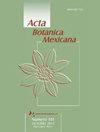Orchidaceae in the Parque Natural Municipal da Restinga de Praia do Forte, Bahia, Brazil
IF 0.8
4区 生物学
Q4 PLANT SCIENCES
引用次数: 0
Abstract
Background and Aims: Bahia is one of the Brazilian states with the greatest diversity of orchids. Species restricted to microhabitats or forming small populations, being subject to local suppression, have been reported for restingas of the state. The north coast of Bahia has recently been exposed to intense anthropic pressures, including disordered occupation of land and predatory tourism. In order to encourage the adoption of regional conservation strategies, we carried out a survey of the orchid flora in the Parque Natural Municipal da Restinga de Praia do Forte (PNMR Praia do Forte), a fragment of restinga on the north coast of the state. Methods: Field work was conducted monthly from September 2016 to December 2017, and in July 2020 and August 2022, by employing the walking survey method. We consulted collections of the herbaria ALCB, HRB, HUEFS, and RB in person, as well as digital images of type specimens deposited in European herbaria and the Environmental Information Reference Center database. Phenological and distribution data of the species in the phytophysiognomies of PNMR Praia do Forte were mostly obtained in the field. Key results: Orchidaceae is represented by 14 genera and 16 species in the PNMR Praia do Forte, most of which are native to the Neotropics (14 spp., including eight endemic to Brazil), mainly terrestrial (six spp.), occurring exclusively in restinga forest formations (eight spp.). Epistephium williamsii, Gomesa barbata, Oeceoclades maculata, Pachygenium parvum, Polystachya concreta and Prescottia leptostachya (restricted to Bahia state) form small populations (<50 individuals). Conclusions: The orchid flora of the PNMR Praia do Forte, especially the aforementioned species, requires the attention from managers, in order to implement possible management and conservation actions and prevent them from being suppressed locally. We suggest greater surveillance actions in the park and environmental education actions among local residents and tourists.巴西巴伊亚州雷斯廷加普拉亚杜福特市立自然公园的兰科植物
背景和目的:巴伊亚州是巴西兰花品种最丰富的州之一。据报道,受限于微生境或形成小种群的物种受到当地的抑制,在该州休息。巴伊亚北部海岸最近面临着巨大的人为压力,包括对土地的无序占用和掠夺性旅游。为了鼓励采用区域保护策略,我们对位于该州北部海岸的Restinga de Praia do Forte自然市政公园(PNMR Praia do Forte)的兰花区系进行了调查。方法:2016年9月- 2017年12月、2020年7月和2022年8月每月进行实地调查,采用步行调查法。我们亲自查阅了ALCB、HRB、HUEFS和RB的植物标本馆,以及存放在欧洲植物标本馆和环境信息参考中心数据库中的模式标本的数字图像。PNMR植物地貌中物种的物候和分布数据大多是在野外获得的。主要结果:兰科植物有14属16种,大部分原产于新热带地区(14种,包括巴西特有的8种),主要是陆生植物(6种),只生长在静林带(8种)。williamsii、Gomesa barbata、Oeceoclades maculata、Pachygenium parvum、Polystachya concreta和Prescottia leptostachya(仅限于巴伊亚州)形成小种群(<50只)。结论:PNMR Praia do Forte的兰花区系,特别是上述物种,需要引起管理者的重视,以便实施可能的管理和保护措施,防止其在当地受到抑制。我们建议加强对公园的监督,并加强对当地居民和游客的环境教育。
本文章由计算机程序翻译,如有差异,请以英文原文为准。
求助全文
约1分钟内获得全文
求助全文
来源期刊

Acta Botanica Mexicana
生物-植物科学
CiteScore
1.60
自引率
12.50%
发文量
52
审稿时长
>12 weeks
期刊介绍:
Acta Botanica Mexicana da a conocer trabajos originales e inéditos en todas las áreas de la botánica, incluyendo florística, taxonomía, taxones nuevos para la ciencia, ecología, etnobotánica, paleontología, evolución, conservación, etc. Está dirigida a botánicos mexicanos y extranjeros que aporten información en estas áreas del conocimiento, particularmente con plantas nativas del continente americano. Hasta 2018 apareció cuatro veces al año con una periodicidad estricta en la primera semana de enero, abril, julio y octubre; a partir de 2019 se publica de manera continua, sin periodicidad preestablecida, en formato electrónico y de forma gratuita.
 求助内容:
求助内容: 应助结果提醒方式:
应助结果提醒方式:


